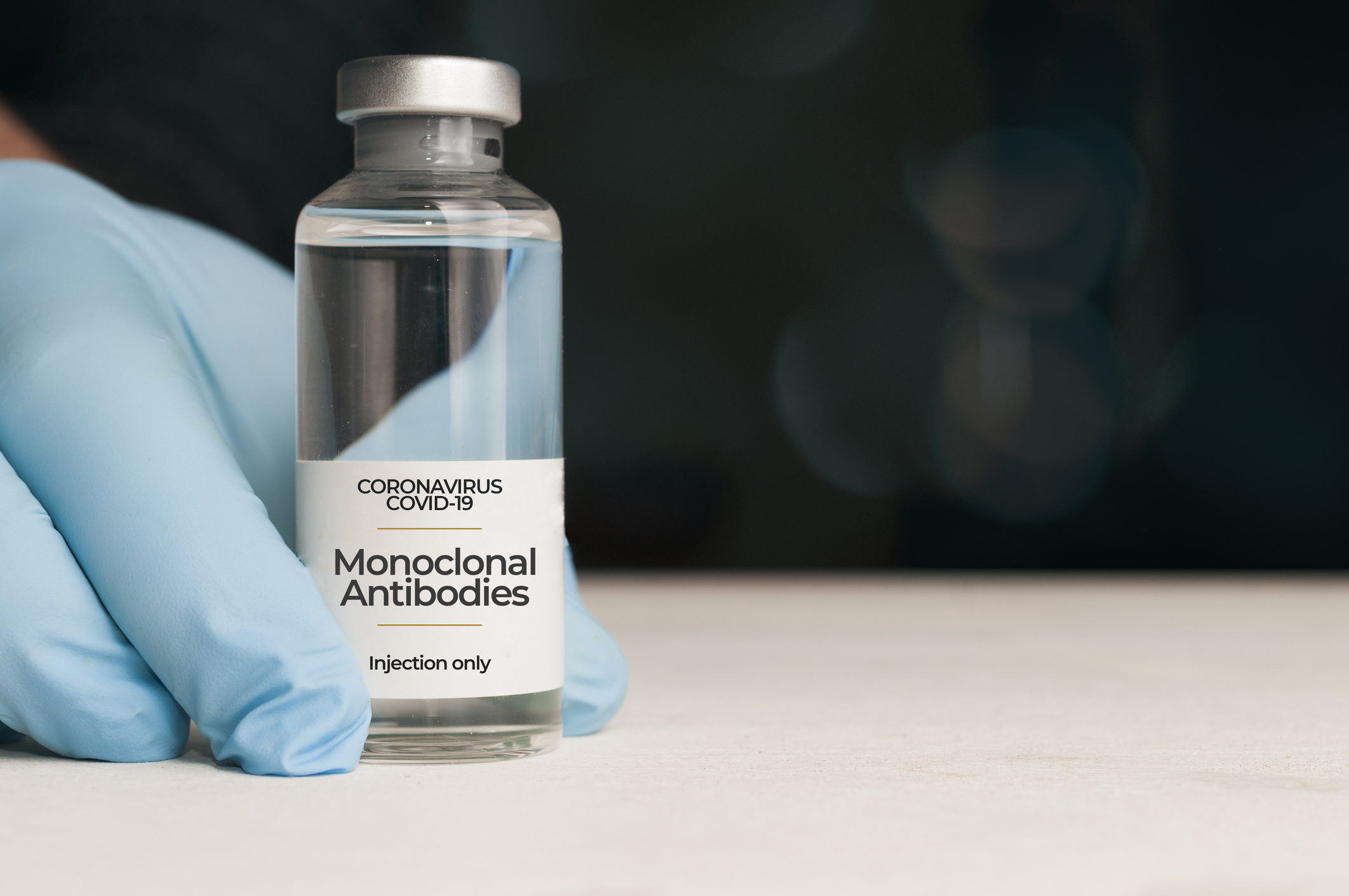
Overview of Monoclonal Antibodies for COVID-19
Monoclonal antibodies have been studied in clinical trials for COVID-19 treatment and work by binding to the SARS-CoV-2 viral spike protein (Chen et al., 2021; Gottlieb, 2021). This prevents the virus from attaching to human cells and allows the SARS-CoV-2 virus to be tagged for destruction. Two monoclonal antibody therapies targeting SARS-CoV-2, bamlanivimab-etesevimab and casirivimab-imdevimab, are available in the US for the treatment of outpatients with mild to moderate COVID-19 and certain risk factors for severe disease.
Overview of FDA EUA:
The FDA emergency use authorization (EUA) for monoclonal antibodies is for the treatment of non-hospitalized mild to moderate COVID-19 in patients who are at high risk for severe disease progression. Bamlanivimab and combination casirivimab/imdevimab were authorized for emergency use in November 2020 and based on the results of the BLAZE-1 trial that showed a reduction in COVID-19-related hospitalizations or death when using the combination monoclonal antibody, combination bamlanivimab/etesevimab was authorized for emergency use in February 2021 (Chen et al., 2021).
It is important to note the EUA for both monoclonal antibody combinations are for non-hospitalized COVID-19 patients with mild to moderate illness (e.g., not requiring supplemental oxygen or, if on chronic supplemental oxygen, without an increased oxygen requirement) who have certain risk factors for severe disease, as defined below
The FDA EUA defines high risk patients as meeting at least one of the following criteria:
- BMI greater equal or greater than 35
- Chronic kidney disease
- Diabetes
- Immunosuppressive disease
- Currently receiving immunosuppressive treatment
- equal or greater than 65 years of age
- equal or greater than 55 years of age AND cardiovascular disease, OR hypertension, OR chronic obstructive pulmonary disease/other chronic respiratory diseases;
- 12 – 17 years of age AND BMI equal or great than 85th percentile, OR sickle cell disease, OR congenital or acquired heart disease, OR neurodevelopmental disorders OR a medical-related technological dependence (example: tracheostomy) OR asthma, reactive airway or other chronic respiratory diseases that requires daily medication for control.
Administration Guidelines:
Bamlanivimab/etesevimab must be diluted prior to administration. It is stored in the refrigerator and must come to room temperature prior to administration. Administer via IV infusion at a rate of equal or greater than 310 mL/hour (equal or greater than 266 mL/hour for patients more than 50 kg using the 250 mL prefilled NS infusion bag) through PVC infusion set.
Bamlanivimab must be diluted prior to administration. It is stored in the refrigerator and must come to room temperature prior to administration. Administer via IV infusion at a rate of equal or greater than 270 mL/hour through PVC infusion set.
Casirivimab and imdevimab must come to room temperature prior to administration. Administer as an IV infusion over equal or greater than 60 minutes through a PVC infusion set.
Clinical Practice Guidelines:
The collaborative CDC and Infectious Disease Society of America (IDSA) guidelines suggest the use of bamlanivimab/etesivimab in outpatient patients with mild to moderate COVID-19 who are at high risk for progression to severe disease (CDC & IDSA, 2021). Bamlanivimab monotherapy or casirivimab/imdevimab may have similar clinical benefits, but data is more limited. Therefore, the IDSA guidelines suggest the use of bamlanivimab/etesevimab over bamlanivimab monotherapy or casirivimab/imdevimab as there is more evidence to support its use. Recommendations for the routine use of monoclonal antibody therapy may change once complete clinical trial results are available for analysis and review. (Whyte & Yancopoulos, 2021).
Monoclonal antibodies have been studied and are understood to play a role in the treatment of outpatients with mild to moderate COVID-19 and certain risk factors for severe disease. As research on monoclonal antibody therapy continues it is likely that recommendations for use may change, enforcing the need for healthcare providers to stay abreast of current research and practice changes in this area.
References
CDC and IDSA (2021). COVID-19 Real-Time Learning Network. Monoclonal Antibodies. Chen, P., Nirula, A., Heller, B., Gottlieb, R. L., Boscia, J., Morris, J., … BLAZE-1 Investigators (2021). SARS-CoV-2 neutralizing antibody LY-CoV555 in outpatients with Covid-19. The New England Journal of Medicine, 384(3), 229–237. Gottlieb, R. L., Nirula, A., Chen, P., Boscia, J., Heller, B., Morris, J.,... Skovronsky, D. (2021). Effect of bamlanivimab as monotherapy or in combination with etesevimab on viral load in patients with mild to moderate COVID-19: A randomized clinical trial. JAMA, 325(7), 632–644. Doi: Whyte, J., Yancopoulos, G. (2021). Latest updates on monoclonal antibodies. Medscape.




